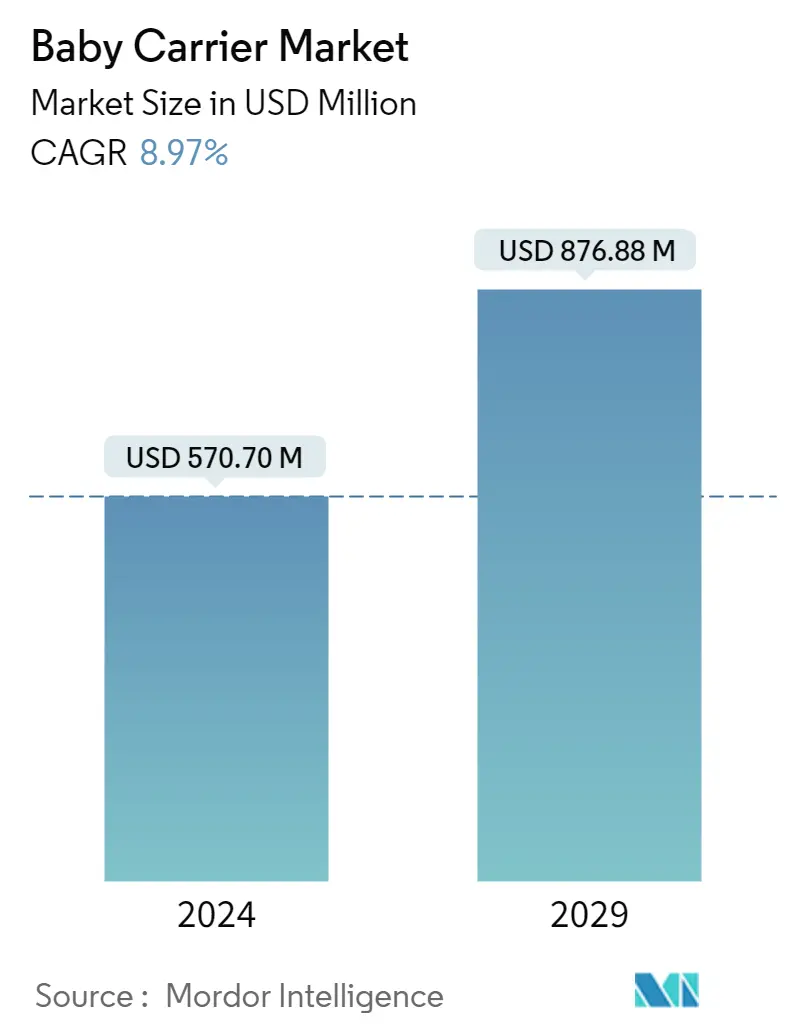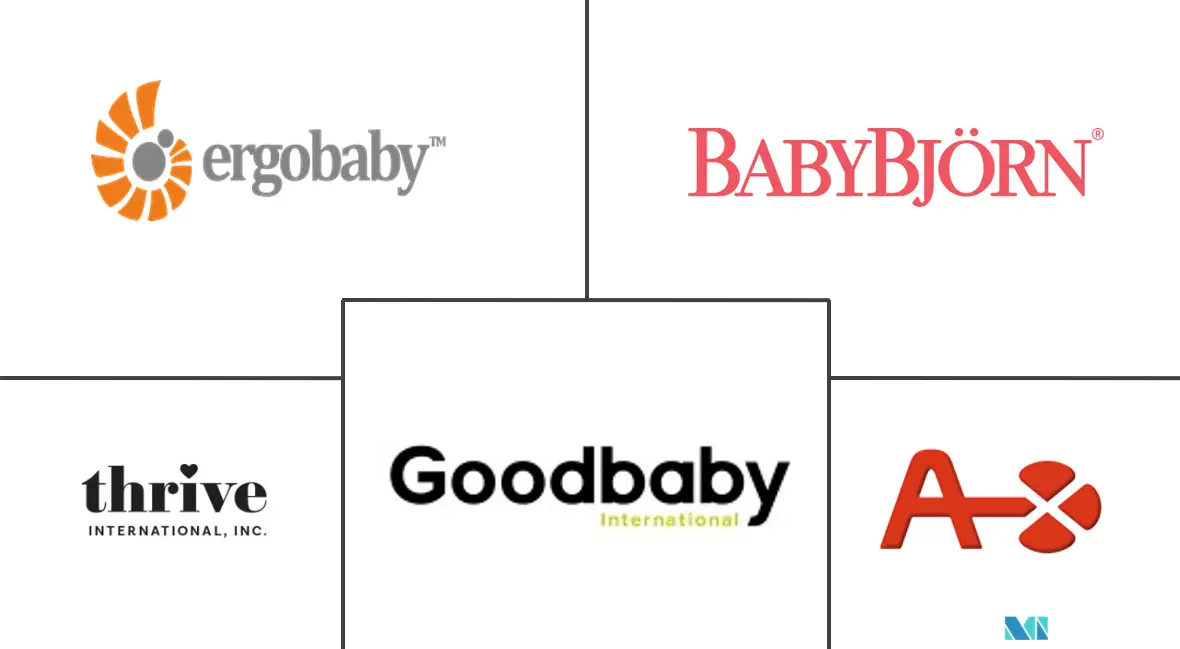Market Size of Baby Carrier Industry

| Study Period | 2019 - 2029 |
| Market Size (2024) | USD 570.70 Million |
| Market Size (2029) | USD 876.88 Million |
| CAGR (2024 - 2029) | 8.97 % |
| Fastest Growing Market | Asia Pacific |
| Largest Market | North America |
Major Players
*Disclaimer: Major Players sorted in no particular order |
Baby Carrier Market Analysis
The Baby Carrier Market size is estimated at USD 570.70 million in 2024, and is expected to reach USD 876.88 million by 2029, growing at a CAGR of 8.97% during the forecast period (2024-2029).
The market for baby products is constantly growing as it makes a mother's life easier as a parent. It also ensures that the baby is stimulated correctly and safely while traveling and sleeping. The International Hip Dysplasia Institute has approved various brands as hip-healthy based on multiple parameters, thereby ensuring the child's safety. In the global baby carriers market, players have developed innovative and technologically advanced products to have a superior hold on the market. The technologically advanced baby carriers ensure higher levels of safety. Carriers with functions, such as the fully adjustable and easy-to-use baby carrier to hold infants and young children, crossable shoulder straps for better comfort and personalized fit, machine washable, and carrier with three ergonomic carry positions, such as front-inward, hip, and back carry, are among the innovative products introduced in the market. Moreover, the adjustable designs allow the mothers to do hands-free breastfeeding on the go. Ease of mobility, innovation in functionality and style, and the demand for ergonomically designed carriers are the key reasons for the popularity of baby carriers worldwide. Unlike prams and strollers, baby carriers are preferred, as they increase the physical and psychological connection between the infant and the parent.
The industry's growth has also been supported by an increasing number of certified babywearing consultants (people who are trained to teach others about the safe and comfortable use of baby carriers) and organizations, like Babywearing International, that seek to educate parents and other caregivers about how to use wraps and slings. The report offers market size and values in (USD Million) during the forecasted years for the above segments.
Baby Carrier Industry Segmentation
A baby carrier is a cloth that supports an infant or other small child from a carer's body.
The baby carrier market is segmented by product type, distribution channel, and geography. Based on product type, the market is segmented into the buckled baby carrier, baby wrap carrier, baby sling carrier, and other product types. By distribution channel, the market is segmented as supermarkets/hypermarkets, specialty stores, online retail stores, and other distribution channels. The study also covers the global analysis of major regions like North America, Europe, Asia-Pacific, South America, and the Middle East and Africa. The key countries have been covered under every region, accounting for most of the market studied.
For each segment, the market sizing and forecasts have been done based on value (in USD million).
| Product Type | |
| Buckled Baby Carrier | |
| Baby Wrap Carrier | |
| Baby Sling Carrier | |
| Other Product Types |
| Distribution Channel | |
| Supermarkets/Hypermarkets | |
| Specialty Stores | |
| Online Retail Stores | |
| Other Distribution Channels |
| Geography | |||||||||
| |||||||||
| |||||||||
| |||||||||
| |||||||||
|
Baby Carrier Market Size Summary
The baby carrier market is experiencing robust growth, driven by the increasing demand for products that enhance parental convenience and ensure infant safety. This market is characterized by the introduction of innovative and technologically advanced baby carriers that offer features such as adjustable designs, crossable shoulder straps, and multiple ergonomic carry positions. These advancements not only provide ease of mobility but also foster a stronger physical and psychological bond between parents and their infants, distinguishing baby carriers from other baby transport options like prams and strollers. The market's expansion is further supported by the growing number of certified babywearing consultants and organizations that educate caregivers on the safe use of these products. The rising consumer interest in ergonomically designed and lightweight carriers, along with the demand for eco-friendly materials, is propelling the market forward.
The global baby carrier market is highly competitive and fragmented, with numerous players striving to capture market share through product innovation and strategic partnerships. Companies are increasingly focusing on merging comfort with fashion, catering to modern parents who prioritize both functionality and style. The introduction of organic and plant-based materials in baby carrier designs reflects the industry's response to the growing consumer preference for sustainable products. Additionally, social media platforms are significantly influencing purchasing decisions, particularly among millennial mothers, by shaping trends in baby and child-specific products. The market's growth is also bolstered by regulatory standards in regions like North America, which enhance product quality and safety, thereby increasing demand. Key players in the market are actively engaging in mergers, acquisitions, and expansions to strengthen their market presence and optimize their offerings.
Baby Carrier Market Size - Table of Contents
-
1. MARKET DYNAMICS
-
1.1 Market Drivers
-
1.2 Market Restraints
-
1.3 Porter's Five Forces Analysis
-
1.3.1 Threat of New Entrants
-
1.3.2 Bargaining Power of Buyers/Consumers
-
1.3.3 Bargaining Power of Suppliers
-
1.3.4 Threat of Substitute Products
-
1.3.5 Intensity of Competitive Rivalry
-
-
-
2. MARKET SEGMENTATION
-
2.1 Product Type
-
2.1.1 Buckled Baby Carrier
-
2.1.2 Baby Wrap Carrier
-
2.1.3 Baby Sling Carrier
-
2.1.4 Other Product Types
-
-
2.2 Distribution Channel
-
2.2.1 Supermarkets/Hypermarkets
-
2.2.2 Specialty Stores
-
2.2.3 Online Retail Stores
-
2.2.4 Other Distribution Channels
-
-
2.3 Geography
-
2.3.1 North America
-
2.3.1.1 United States
-
2.3.1.2 Canada
-
2.3.1.3 Mexico
-
2.3.1.4 Rest of North America
-
-
2.3.2 Europe
-
2.3.2.1 Germany
-
2.3.2.2 United Kingdom
-
2.3.2.3 France
-
2.3.2.4 Spain
-
2.3.2.5 Italy
-
2.3.2.6 Russia
-
2.3.2.7 Rest of Europe
-
-
2.3.3 Asia Pacific
-
2.3.3.1 China
-
2.3.3.2 Japan
-
2.3.3.3 India
-
2.3.3.4 Australia
-
2.3.3.5 Rest of Asia-Pacific
-
-
2.3.4 South America
-
2.3.4.1 Brazil
-
2.3.4.2 Argentina
-
2.3.4.3 Rest of South America
-
-
2.3.5 Middle East and Africa
-
2.3.5.1 South Africa
-
2.3.5.2 Saudi Arabia
-
2.3.5.3 Rest of Middle East and Africa
-
-
-
Baby Carrier Market Size FAQs
How big is the Baby Carrier Market?
The Baby Carrier Market size is expected to reach USD 570.70 million in 2024 and grow at a CAGR of 8.97% to reach USD 876.88 million by 2029.
What is the current Baby Carrier Market size?
In 2024, the Baby Carrier Market size is expected to reach USD 570.70 million.

